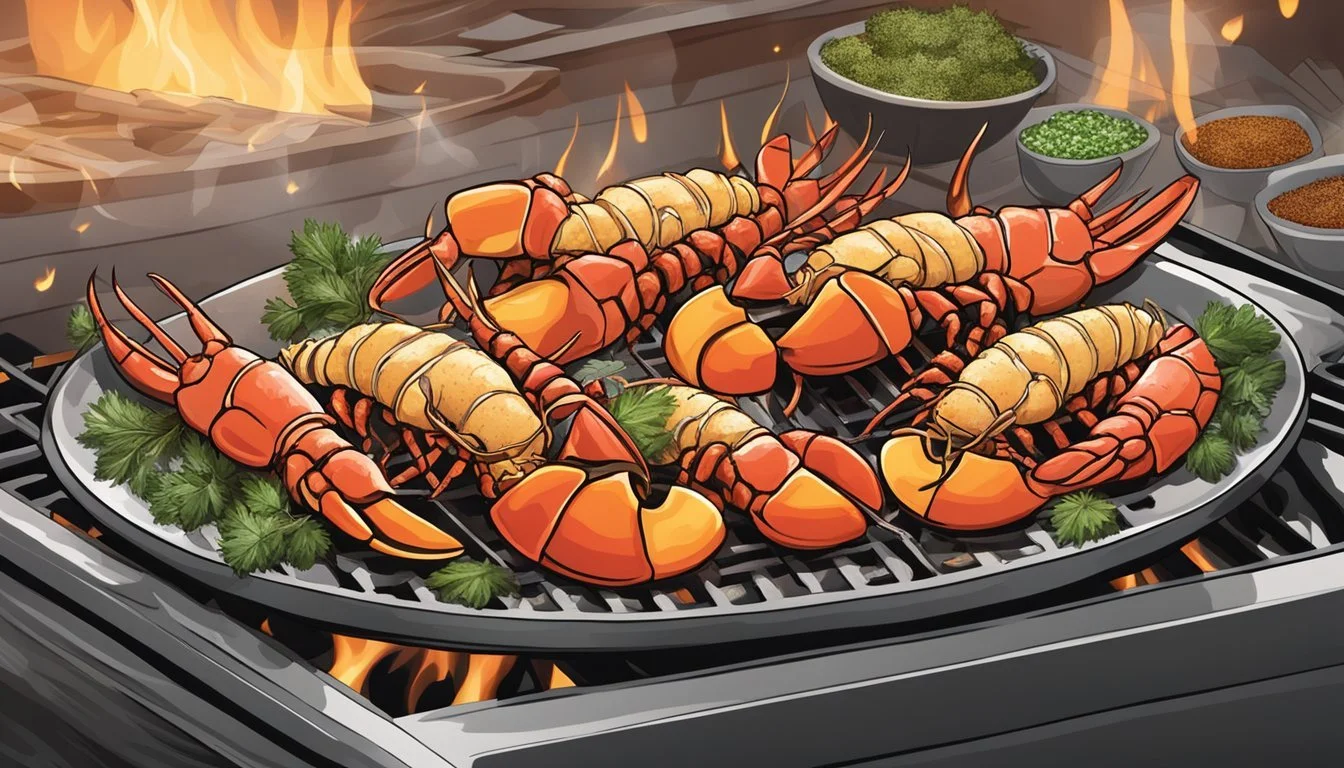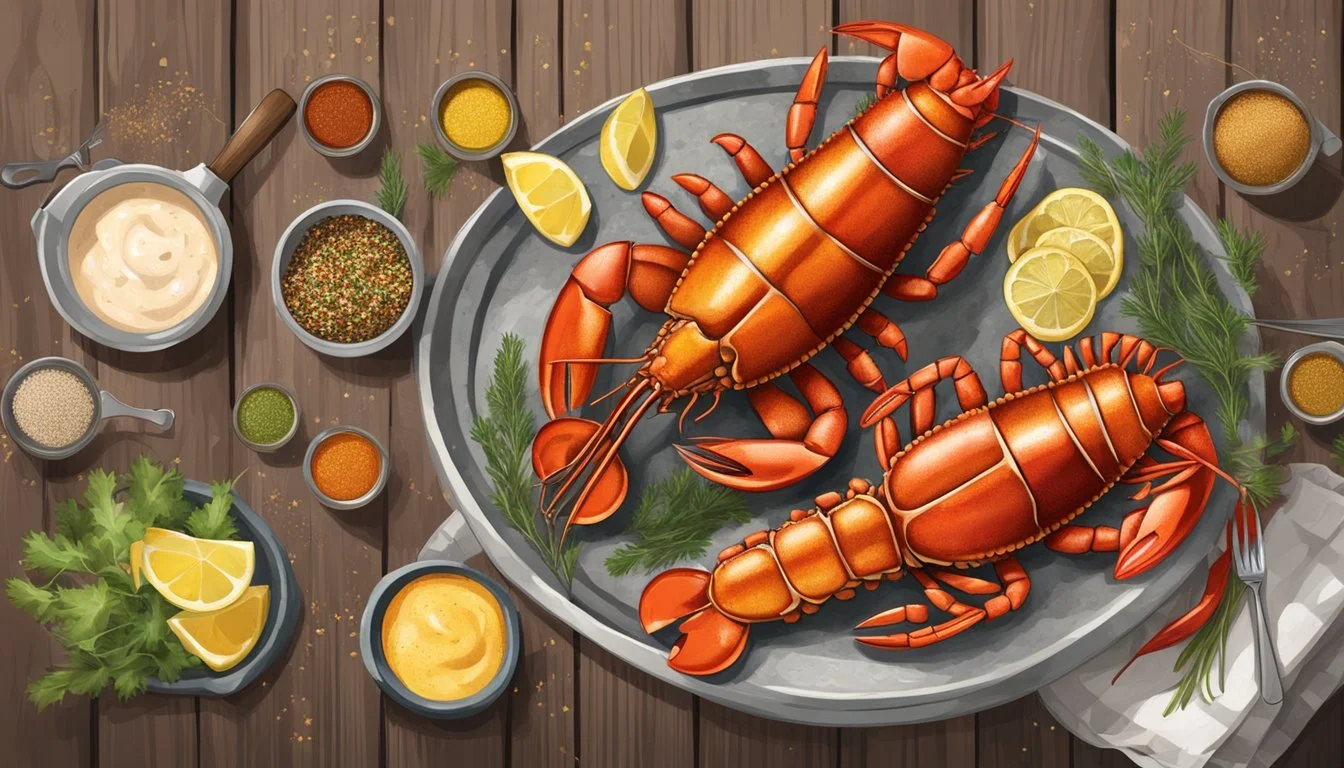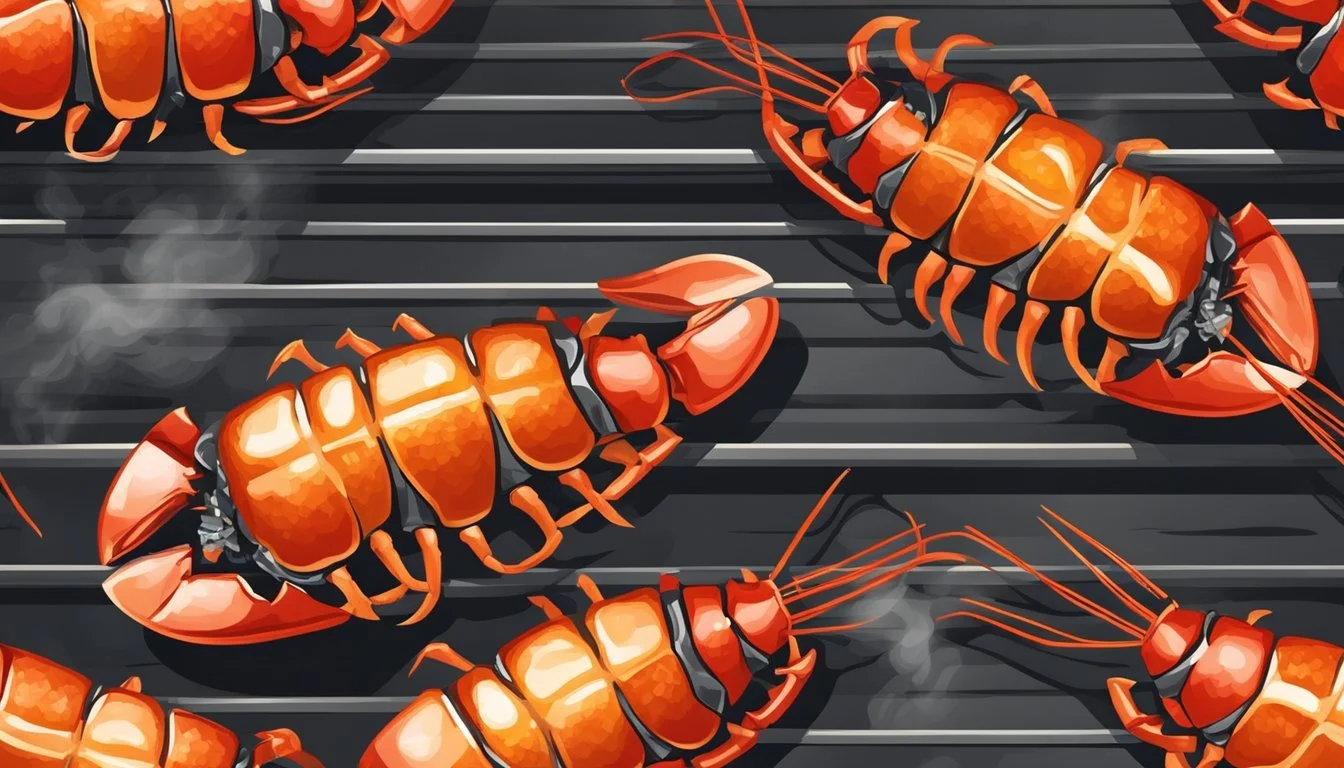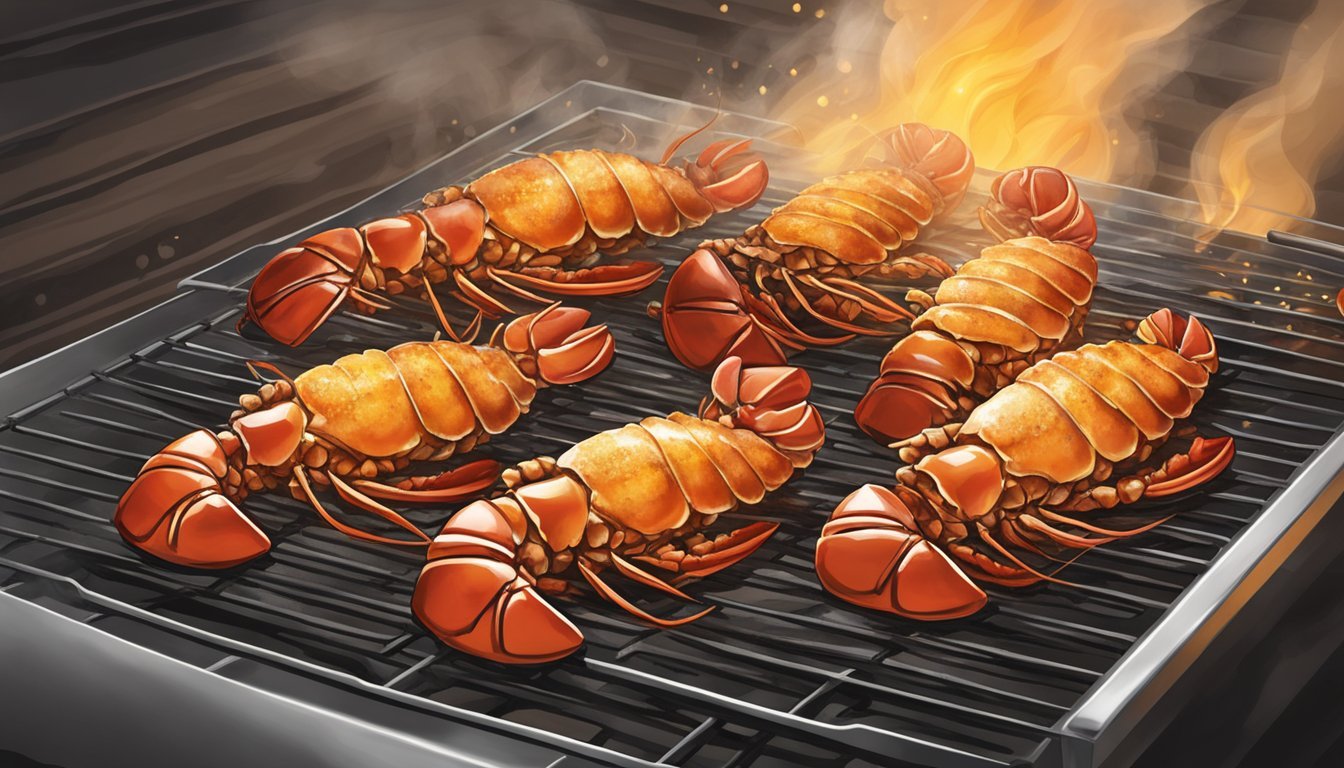How to Grill Texas-Style Lobster Tails
A Step-by-Step Guide
Grilling lobster tails might seem like a gourmet endeavor, but it's actually a straightforward process that adds a touch of Texas flair to this classic seafood dish. In Texas, where everything is done with a little extra character, grilling takes on an art form. The thick, succulent meat of lobster (What wine goes well with lobster?) tails is perfectly complemented by the smoky flavors imparted from a well-managed grill. Lobster tails are often regarded as the ultimate comfort food, evoking images of seaside dining and special occasions, yet their preparation can be deceptively simple and incorporated into any backyard barbecue.
To grill lobster tails in true Texas style, one needs to focus on both technique and ingredients. A few key steps can ensure that the lobster tails are not only cooked to perfection but also imbued with a bold smokiness that doesn't overpower the natural, delicate flavor of the lobster. Starting with fresh lobster tails, the grilling process involves splitting the shells and seasoning the meat with a blend of savory spices befitting of a Texan palate. Whether it's for an intimate dinner or a grand feast, grilled lobster tails promise to be the showstopping centerpiece.
Each stage of preparing and grilling lobster tails is crucial - from cutting the shell to exposing the meat, to applying a glaze or rub that complements the rich texture. Grilling them to perfection requires careful attention to the heat and timing to avoid overcooking. The result should be lobster tails that are tender and moist, with a slightly crisp, charred exterior that enhances the overall dining experience. Thus, grilling lobster tails not just preserves but elevates their natural succulence, making them a worthy addition to any special occasion menu.
Selecting the Best Lobster Tails
For an unforgettable Texas-style grilled lobster tail, one must choose the right lobster tails. Freshness and quality are paramount for the best taste and texture.
Understanding Lobster Varieties
Lobster comes in various species, each with unique characteristics. Cold-water lobsters, often from the Atlantic, tend to have whiter, sweeter meat and a firmer texture, making them highly desirable for grilling. Warm-water lobsters can have a more fibrous texture but are still a valid option if sourced correctly. One should aim for a lobster tail from a cold-water species like the North Atlantic for a superior Texas-style grill.
Cold-Water Lobster Warm-Water Lobster Sweeter, firmer meat Usually more fibrous Mainly from the Atlantic Found in warmer seas Preferred for grilling Quality can vary
Where to Purchase Quality Lobster
Lobster tails can typically be purchased at seafood markets or from specialty online suppliers. When buying lobster tails, always:
Ensure they are fresh or properly frozen
Look for translucent, moist flesh without any discoloration
Smell, as they should have a fresh sea aroma and not an overly fishy scent
One might find quality lobster tails at:
Local seafood markets, where freshness is often a priority
Reputable grocery stores with a good seafood turnover
Specialty online retailers who guarantee next-day delivery for optimal freshness
Buying lobster tails from these sources can provide them with exceptional seafood suited for a Texas-style BBQ experience.
Preparation Essentials
Grilling Texas-style lobster tails begins with proper storage and thawing, along with adequate preparation of seasonings for a memorable feast. The chef should be equipped with a sharp knife and kitchen shears, and the kitchen must be ready for action with essentials like olive oil, salt, and pepper.
Storage and Thawing Instructions
When dealing with lobster tails, it's paramount to store them in the coldest part of the fridge, ensuring they remain fresh until it's time to grill. If the lobster tails are frozen, they should be thawed gradually in the refrigerator for up to 24 hours. Placing them in a container to prevent any leaking onto other foods is also a good practice for food safety.
Prep Time and Initial Steps
The chef should allocate approximately 15 minutes for the preparation of lobster tails. One starts by using kitchen shears to split the top shell down the middle. Carefully pull apart the shells and loosen the meat with a sharp knife. This will allow the rub to penetrate more effectively and provide even cooking. Lightly coat the flesh with olive oil, which helps the seasoning to adhere and prevents sticking on the grill.
Components of a Flavorful Rub
For a Texas-style kick, one should craft a dry rub that’s bold yet balanced:
Ingredient Quantity Coarse Salt 1 tsp Black Pepper 1/2 tsp Paprika 1 tsp Garlic Powder 1/2 tsp Chili Powder 1/2 tsp Cumin 1/4 tsp
Rub the mixture on the flesh of the lobster tails. This fusion of spices will give the lobster a rich, smoky flavor that's distinctive to Texas-style grilling. The chef should ensure each tail is evenly coated before it hits the heat.
Grilling Techniques
When grilling Texas-style lobster tails, one must pay close attention to the grill setup, the technique for achieving grill marks, and the method for monitoring internal temperature to ensure perfectly grilled lobster.
Grill Setup for Lobster Tails
The first step to grilling lobster tails is preparing the grill. One should heat the grill to a medium-high temperature, which typically falls between 350°F to 450°F. If using a charcoal grill, the coals should be heated until they are covered in a layer of white ash. For a backyard BBQ or smoker, the setup should maintain a consistent temperature throughout the cooking process.
Direct Heat: Position the lobster tails on the grill over direct medium heat for initial searing.
Indirect Heat: Once seared, move the tails to indirect heat if needed to avoid overcooking.
Achieving Perfect Grill Marks
Grill marks are not only about aesthetics; they're a sign of properly cooked shellfish. (What wine goes well with shellfish?) For pristine marks:
Preheat the Grill Grates: Ensure the grates are hot before placing the lobster tails flesh side down.
Do Not Move the Lobster: Allow the tails to cook undisturbed for about 4-5 minutes to set the marks.
Flip Once: Carefully flip the tails using tongs to avoid tearing the flesh and cook for an additional 4-5 minutes.
Monitoring Internal Temperature
Ensuring the lobster tails are cooked to perfection involves closely monitoring the internal temperature:
Meat Finish Temp: The internal temperature must reach 140°F for a fully cooked lobster. Use a meat thermometer inserted into the thickest part of the flesh, not touching the shell.
Smoker Temp: If smoking lobster tails, maintain a smoker temperature between 225°F and 250°F, checking the internal temperature regularly.
By strictly controlling the temperature and cooking times, the lobster will be smoked to tenderness without drying out.
Flavor Enhancements
Enhancing the flavor of Texas-style lobster tails revolves around the creation of rich, aromatic garlic butter and the careful selection of complementary spices that accentuate the natural sweetness of the lobster meat.
Making Garlic Butter
The chef starts by crafting a garlic butter that serves as the cornerstone for flavoring the lobster tails. Garlic butter involves combining melted unsalted butter with finely minced garlic, a splash of lemon juice, and chopped parsley. This mixture should be simmered until the flavors meld together, releasing a fragrant aroma indicative of its readiness for use.
Ingredients for Garlic Butter:
1/2 cup of unsalted butter
4 cloves of garlic, minced
1 tablespoon of freshly squeezed lemon juice
2 tablespoons of fresh parsley, chopped
Instructions:
Melt the butter over low heat.
Add the minced garlic and lemon juice to the melted butter.
Stir in chopped parsley and simmer for 1-2 minutes, ensuring not to burn the garlic.
Choosing Complementary Spices
The chef thoughtfully selects spices that complement the rich flavors of the garlic butter without overwhelming the natural seafood taste. A hint of nutmeg can offer a warm and nutty undertone, while a pinch of sea salt and black pepper ensures the lobster tails are seasoned to perfection.
Suggested Spice Blend:
1/4 tsp of ground nutmeg
1/2 tsp of sea salt
1/4 tsp of freshly ground black pepper
Application:
Combine the spices in a small bowl.
Sprinkle the spice mixture evenly over the lobster tails prior to grilling.
Creative Grilling Ideas
When grilling Texas-style lobster tails, one can enhance the culinary experience with the right accompaniments, the infusion of smoke, and by experimenting with various seafood combinations.
Side Dishes and Accompaniments
For a well-rounded meal, side dishes can complement the rich flavor of lobster. One might consider:
Grilled Vegetables: Asparagus or zucchini grilled with a touch of olive oil and sea salt can add a fresh taste.
Potatoes: Roasted or mashed potatoes seasoned with garlic and chives make a hearty pair for lobster tails.
Corn on the Cob: A classic partner for seafood, grill corn alongside the lobster for a smoky sweetness.
Pair the meal with an oaked chardonnay to balance the richness of the lobster with its buttery notes.
Infusing Smoke for Depth of Flavor
By incorporating smoke, one can add a new dimension of flavor to grilled lobster tails:
Wood Chips: Soaking apple wood or hickory chips and placing them directly on the coals can infuse a subtle smokiness.
Herbs: Adding sprigs of rosemary or thyme to the grill can impart a delicate aromatic smoke.
The smoke should be present but not overpowering, as to not mask the natural flavors of the lobster.
Experimenting with Seafood Combinations
Pairing lobster with other seafood can create a luxurious surf-and-turf experience:
Shrimp: Grilled shrimp skewered alongside lobster tails can offer a varying texture and taste.
Salmon: A fillet of salmon, seasoned simply with salt, pepper, and citrus, can provide a rich, oily counterpoint to the sweet lobster meat.
Shellfish: Clams (What wine goes well with clams?) or oysters grilled until just open can be a succulent starter to the lobster main course.
For an indulgent dish, one might also serve lobster fettuccine, where tender chunks of grilled lobster are tossed with pasta in a creamy sauce.
Finishing Touches and Presentation
The final toppings and plate decoration elevate the grilled lobster tails from mere grilled seafood to Texas-style culinary delicacy. Appropriate garnishing and presentation not only enhance the flavors but also contribute greatly to the visual appeal of the dish.
Applying the Final Toppings
After grilling, the chef drizzles the lobster tails with a rich butter mixture. This typically includes melted butter blended with seasonings such as cayenne for heat and chopped fresh parsley for an herbaceous note. They may opt to sprinkle a mixture of finely grated parmesan cheese over the lobster tails while they are still warm to allow the cheese to melt slightly, adhering to the succulent meat.
Plate Decoration and Serving Suggestions
The presentation begins with a clean, white plate that makes the vibrant lobster color pop. Lemon wedges are arranged to provide a citrus note that guests can add at their discretion. If including sides like chopped lobster or clams, these are portioned neatly alongside the tails. Each lobster tail is often garnished with a light sprinkle of parmesan cheese and a sprig of fresh parsley to complete the look. The server brings the dish to the table with confidence, knowing that both the flavor profiles and visual elements have been expertly crafted to provide an exceptional dining experience.
Social Sharing and Engagement
In the vibrant world of grilling enthusiasts, social sharing and engagement are vital for connecting with fellow foodies and showcasing Texas-Style grilled lobster tails. From capturing the perfect char to engaging followers, a strategic approach leverages the power of social media.
Capturing Grilling Moments
For those who take pride in their grill, capturing the essence of a perfectly grilled lobster tail is as important as the grilling itself. High-quality images or videos showcasing the rich, red shell contrasted against the smoke-infused meat can be a feast for the eyes on platforms like Instagram and Facebook. They should consider the following:
Lighting: Utilize natural light for the most appetizing photos.
Angles: Shoot from multiple angles to highlight the lobster's texture and char.
Engaging on Social Platforms
Consistent engagement on platforms like YouTube, Facebook, and Instagram helps grillers build a loyal audience. Chefs should share their grilling process, from seasoning the lobster tails to achieving the ideal internal temperature. Here are key engagement strategies:
Recipes and Tips: Share detailed recipes and grilling techniques.
Interaction: Respond to comments and questions to build a community.
Hashtags: Use relevant hashtags, such as #GrilledLobster and #TexasBBQ, to reach a broader audience.
Safety and Clean-Up
Grilling Texas-Style lobster tails is an enjoyable culinary experience, but safety and clean-up are essential aspects. One should approach the process with care, especially when using kitchen shears, a grill, or smoker.
Before Grilling:
Ensure the grill or smoker is stable and located in a well-ventilated area away from any flammable materials.
Kitchen shears, utilized for splitting lobster tails, should be handled with caution and kept out of children's reach.
During Grilling:
Always use long-handled utensils to manage the lobster tails on the grill to prevent burns.
It's crucial to monitor the grill or smoker's temperature to prevent overcooking or flare-ups, which can occur with fatty drippings.
After Grilling:
Wait for the grill to cool completely before attempting any clean-up procedures.
Remove any residue with a grill brush or scraper, ensuring the grates are clean for the next use.
Disposal:
Deposit used lobster shells and any other organic waste in a bin designated for compostable materials if available.
Extinguish coals in a charcoal grill or smoker properly and dispose of them in a metal container to prevent accidental fires.
Cleaning Tools:
Wash and sanitize kitchen shears and other utensils in hot, soapy water or a dishwasher if they are dishwasher-safe.
By maintaining vigilant safety practices and thorough clean-up routines, individuals can ensure a pleasant and hazard-free grilling experience.
Additional Tips and Tricks
Mastering the grill for Texas-style lobster tails involves more than just cooking times and temperatures. The following subsections provide key insights on handling smaller lobster tails effectively, selecting beverages for a harmonious pairing, and creatively transforming leftovers into a delightful next meal.
Handling Smaller Lobster Tails
When grilling smaller lobster tails, it is crucial to avoid overcooking. They should be monitored closely due to their faster cooking time compared to larger tails. Skewering these tails before placing them on the grill can help maintain their shape and promote an even cook. One should skewer from end to end, ensuring they lay flat against the grill surface for a consistent sear.
Pairing with Beverages
The rich flavor profile of grilled lobster tail pairs exceptionally well with an oaked Chardonnay. This full-bodied white wine complements the smoky and buttery nuances of the seafood. A cold, crisp beer, such as a lager, can also serve as a refreshing counterpoint to the lobster's succulence, suitable for a balmy Texan evening.
Making Leftovers Delightful
Repurposing lobster tail leftovers into another meal is both resourceful and satisfying. Lobster can be chopped and added to a seafood pasta or a creamy lobster bisque, turning a simple dish into the ultimate comfort food. The key is gentle reheating to preserve the lobster's tender texture. Using a low heat setting allows the meat to warm without becoming tough or rubbery.
Conclusion
Grilling lobster tails Texas-style provides a sumptuous meal with a smoky touch that's perfect for gatherings or a decadent dinner at home. A successful endeavor rests on careful preparation and mindful grilling.
Firstly, grillers should ensure their lobster tails are fresh and prepped correctly, with meat exposed to absorb flavors. Lobster tails, being the centerpiece, demand medium-high heat on the grill — a heat that sears the meat without drying it out.
During the grilling process, monitoring is key. Lobster should be grilled meat side down initially, then flipped to finish cooking. Overcooking risks a tough texture, so aim for an opaque, firm meat with an internal temperature of 140°F. A meat thermometer is an invaluable tool here.
Lastly, enhancing flavor is crucial to nail the Texan flair:
Brush the lobster with garlic butter for richness
Infuse smokiness with a few wood chips on the grill
Serve with a side of seasoned vegetables or a bold Texas-style BBQ sauce
Careful attention to cooking times and robust flavoring will result in perfectly grilled lobster tails that are succulent and infused with the spirit of Texas cuisine. Enjoying the fruits of the grill becomes a memorable experience that underscores the joys of outdoor cooking.








